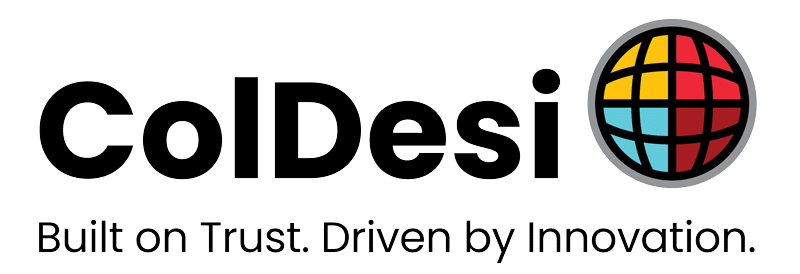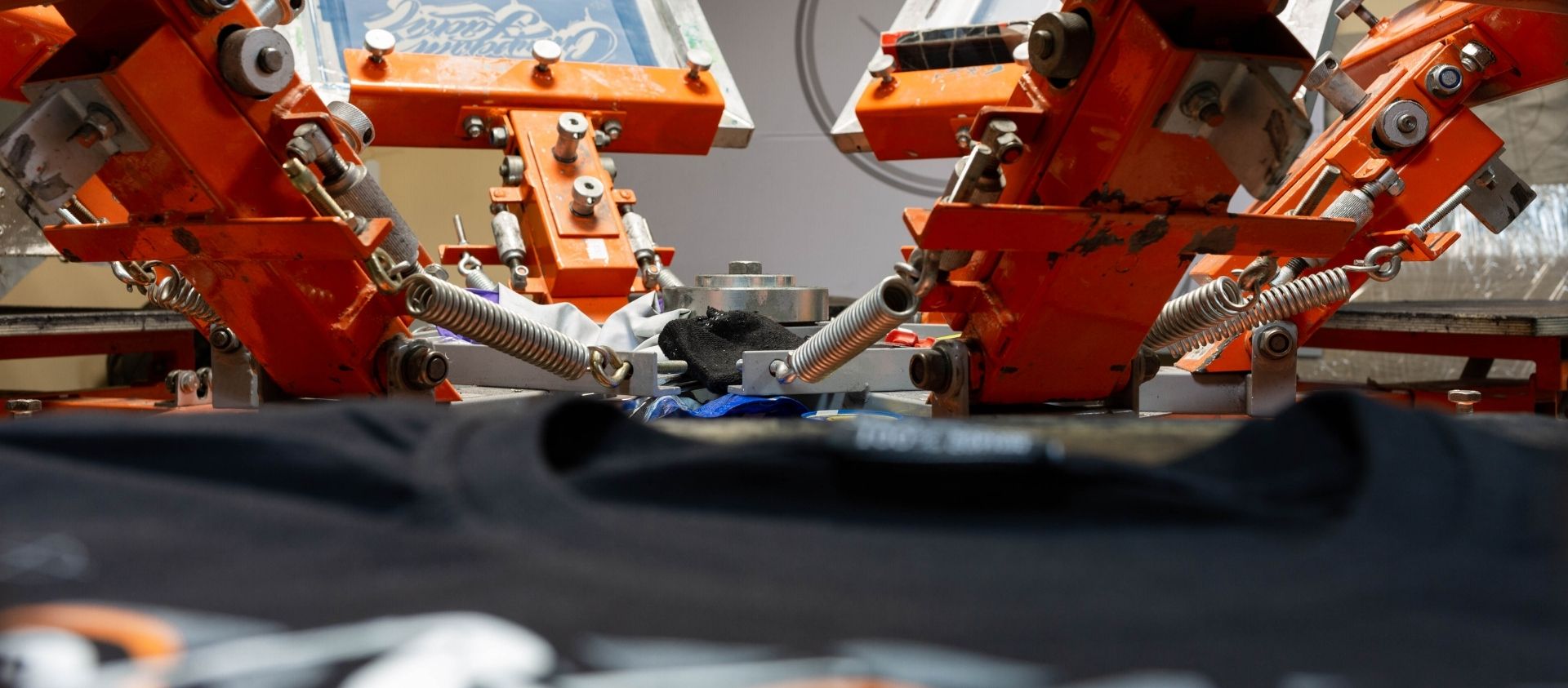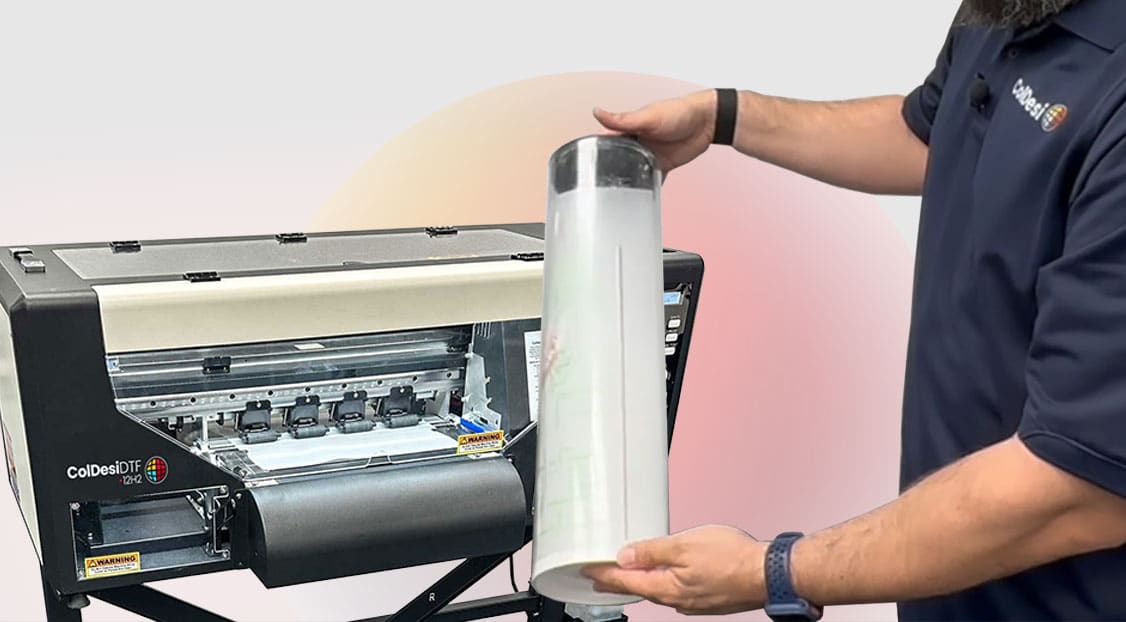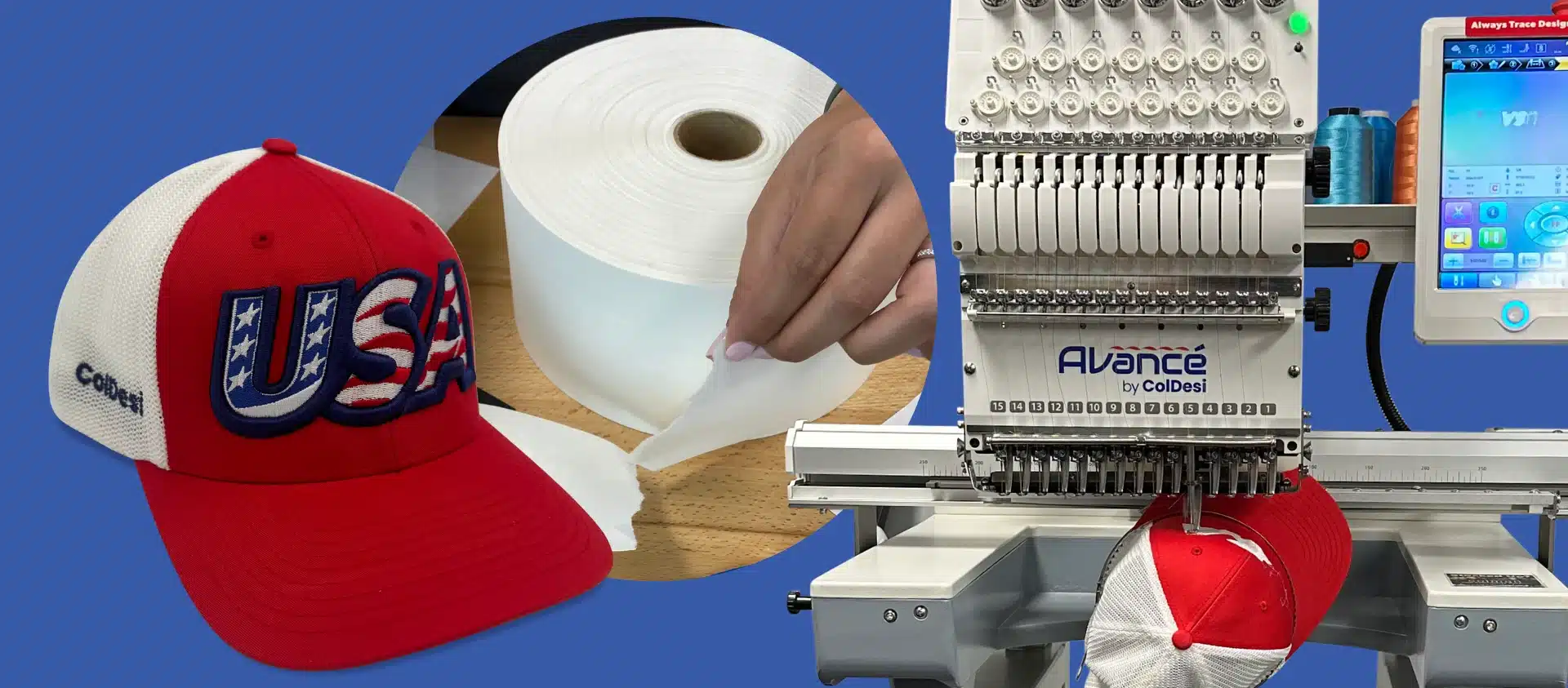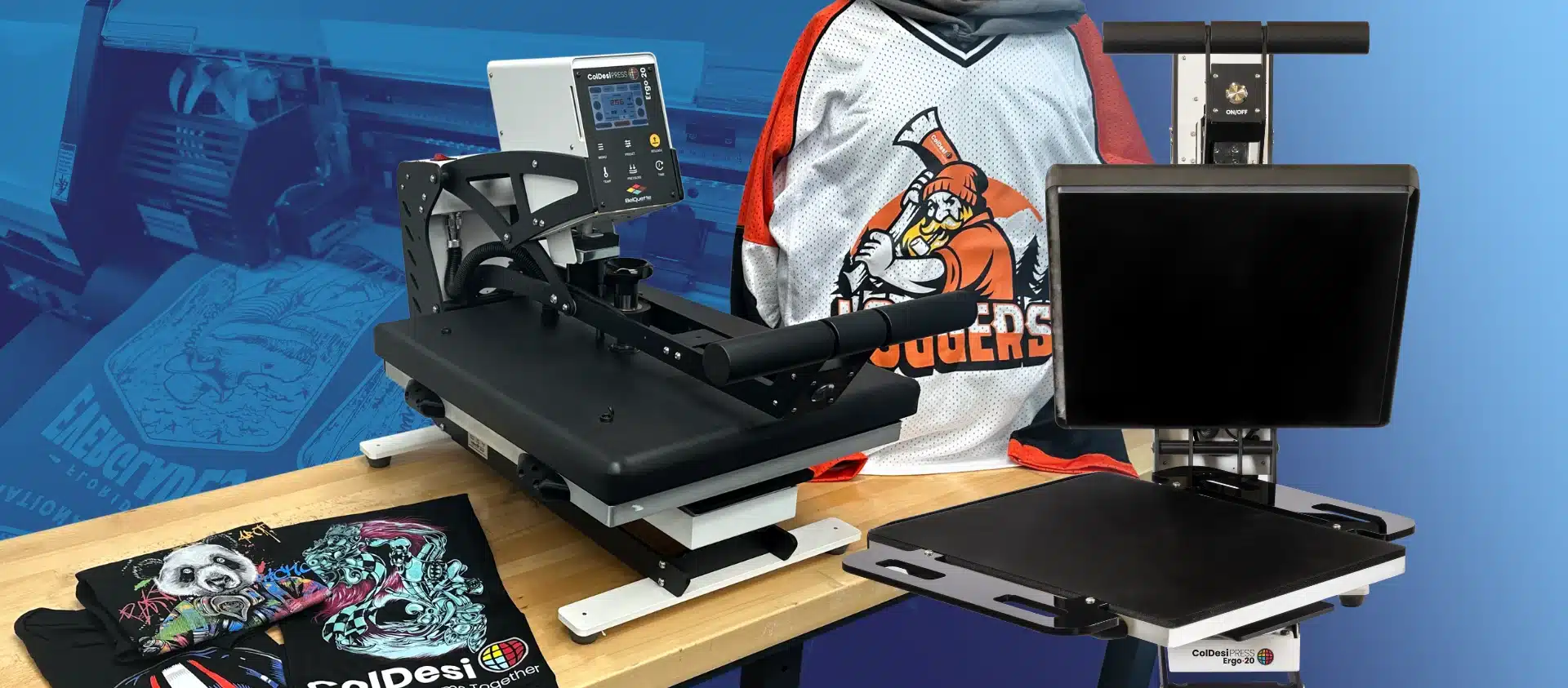Each year, custom products manufacturers are feeling intense pressure to produce custom products faster and more efficiently, while also saving money.
Screen Print / DTG Bottlenecks
The custom products manufacturing process has drifted over the years from direct screen printing (which requires tedious setup and uses screens) to direct digital imaging. Neither of these processes solves all the problems needed for “just in time” apparel and accessory decoration. Neither system is particularly fast when it comes to a small run of shirts – while at the same time allowing for maximum variability in the garments.
Too much time and labor are associated with screen printing for short runs, and there are limitations in colors. Also, too much equipment and the labor costs are associated with direct to garment when doing larger runs. With DTG, it’s hard to justify the ink and pretreatment expense with higher quantities. Then, you also need to hire and/or train highly skilled workers for both systems.
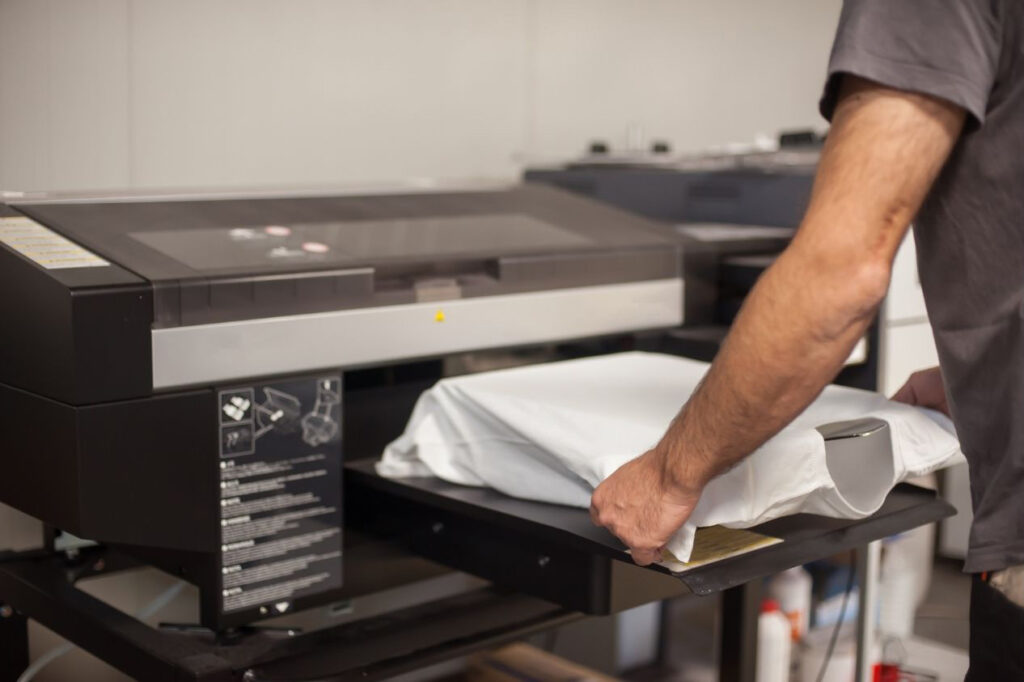
Examples where middle to high volume custom/semi-custom decoration are required would be websites that allow custom designing with no minimums to team sports to special events items like bachelorette parties, IMO (In Memory Of) shirts, team shirts for fundraiser events, family reunions… the list is extensive.
Another example would be licensed or stock designs that become more valuable when offered on the widest selection of garments possible. In the past, the options would be to try to have an inventory of already printed garments in a wide variety of colors, sizes, and styles. Or you might have to try to produce these things one at a time on somewhat expensive, space-consuming direct-to-garment printers. These also come with limitations in the types of fabric they will effectively print on (mostly cotton and cotton blends – synthetics and performance wear are out).
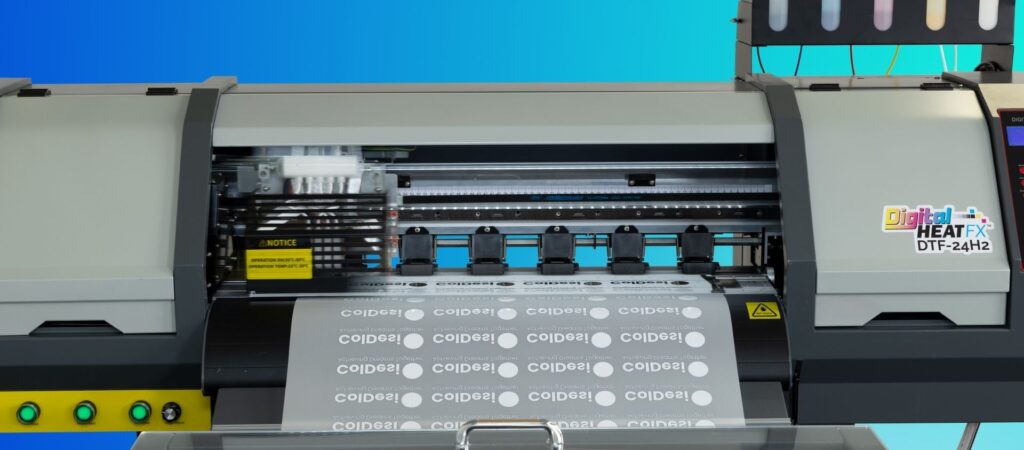
The New Paradigm – Direct to Film
Both these systems require that the t-shirt and the skilled worker meet the machine at the same time.
The worker is tied to the machine. And during that time, little else can be done.
Imagine instead if the machine could print the image onto film completely independent of the operator?
The operator spends their time loading images and adjusting settings for an entire day’s worth of work, then the machine prints, dries, applies adhesive, cures, and rolls up the finished product ready to be cut into transfer sheets. All with truly little adjustment needed from the operator.
Once the rolls of DTF prints are finished, all that remains is to cut and press them onto the t-shirts (or other garments) as necessary. A screen-print system might require three operators to set up and manage a large automatic screen print system, and two more operators to catch garments coming out of the dryer. Can be freed up to cut and press the transfer images onto any colored shirt in virtually any placement in about 10-15 seconds.
That works out to five full channels of garment assembly. Each operator focuses on the assembly of the individual orders and the placement of the transfers for that specific order. Rather than having to wait for one order to finish to move on to the next one.
The workflow is more flexible and expandable. In a rush job situation, you can even reassign unskilled workers to additional overflow heat press machines to maximize the critical path to completion of the job.
The Problem is Straightforward.
- The market demands variety, full color, moderate to extreme level of customization, quick turnaround, competitive pricing.
- Existing methods range from labor intensive processes like screen printing to digital printing methods like direct to garment which are limited by fabric type, inefficient in terms of space, high equipment costs and higher labor costs due to skill level required by operators
- The marketplace is looking for an equipment solution that is:
- Inexpensive to purchase and operate
- Easy to master
- Offers full customization abilities
- Makes efficient use of space
- Produces output quickly
- As well, the marketplace needs software and workflow solutions that integrate with their order system to reduce the need for unnecessary human interface in the order to production stage
- Lastly, there is a need and desire to keep labor costs down by reducing the need for highly skilled operators.
The Solution is Straightforward
- DTF – Direct to Film – printer that can produce from 150-300 square foot of output per hour
- Virtually unlimited fabric options
- Time proven transfer process (same adhesive solution as used in screen printed transfers
- Quick and simple pressing solution (10-15 seconds) no highly skilled operators needed - Low output costs
- Produce 3-5 times the output in the same workspace as compared to direct to garment printing
- No pretreatment process required
- Software solutions for variable data, images, serialization and bar/QR coding
- Training and support from a trusted industry provider with literally hundreds of years of collective experience in the apparel, equipment, and graphics industry
The DTF printing process
DTF printing has grown from a wildcat solution based on converted Epson desktop printers and manual shake and bake adhesion application to purpose-built printers, adhesive applicators, and adhesive curing dryers.
Digital images are printed face down and topped with white ink which remains tacky until an adhesive powder is cascaded on the prints with the excess being vibrated off then cured. The finished images are trimmed and pressed (approx. 10 seconds) with results that are equal in durability and feel to direct print screen printing.
The software included in the ColDesi solution makes efficient use of the media to reduce waste and increase profits – and can be integrated to work with the user’s order system to quickly get orders from the web to production with no human-computer interaction needed until ready to release prints.
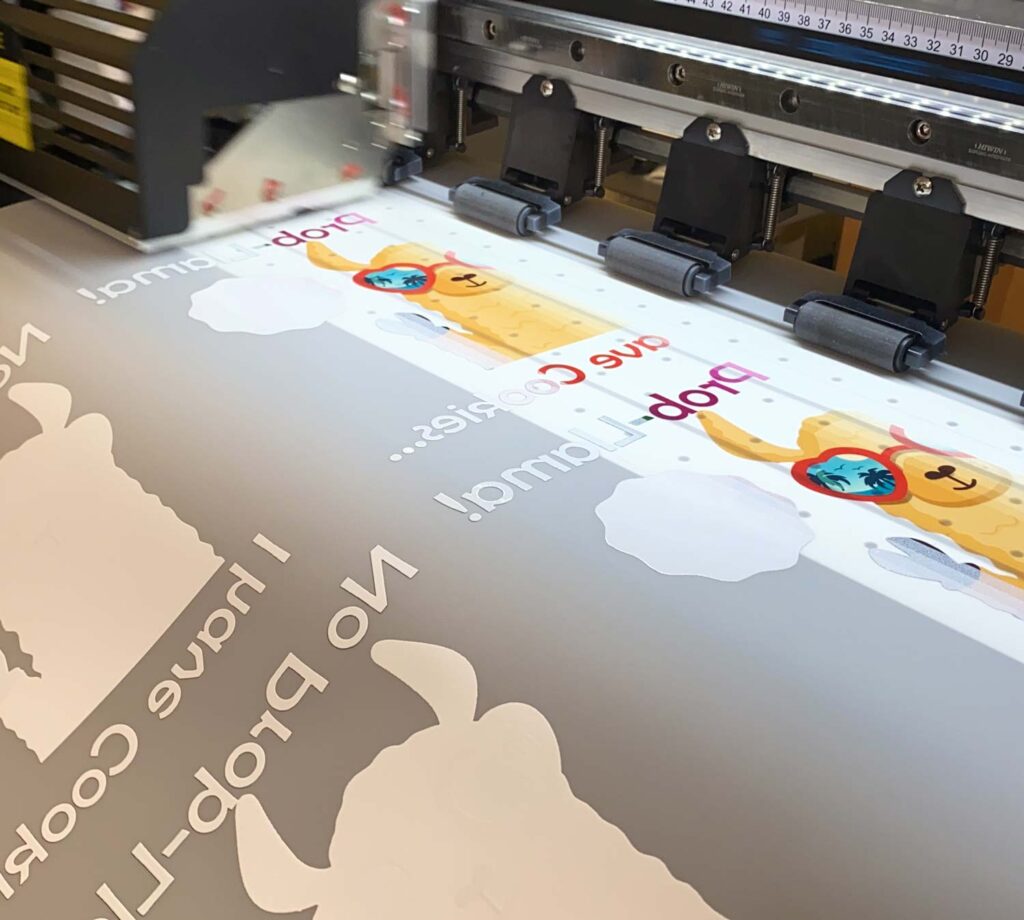
In-Depth Explanation of DTF Printing
DTF printing uses inkjet printers to print aqueous pigmented inks onto a PET (polyethylene terephthalate) film. PET film is used because of its dimensional stability when heated and its non-toxic nature. Images are printed in a mirrored fashion such that the image is “face down” onto the PET film.
The last color to be printed is typically white which is slow drying, leaving it tacky for the acceptance of a powdered adhesive (a hot melt powder made of polyurethane resin). Once the powder has been applied by a process of cascading the powder over the tacky print and shaking/agitating the film to remove any unbonded powder, the film then passes through a heat tunnel that melts the adhesive to bond it with the ink. Leaving the tunnel, the print and adhesive cool and are ready to be applied.
The application process is quite simple, cut the DTF transfer from the roll, press 10-15 seconds at 325’ F, and let cool. Once the print has completely cooled, peel the PET film and your garment is ready. In some cases, it may be beneficial after removing the PET film to return the shirt to the heat press and put a piece of parchment or another curing sheet over the image and press for an additional 10 seconds to ensure the set of the transfer into the garment. Allow 24 hours before washing the garment.
Benefits of DTF over DTG printing
Both DTG and DTF printing bring the ability to offer short-run, high color garments to your customer base. Graphic preparation is essentially the same and the technology of printing (inkjet) is the same for each. Even the inks are very similar – DTF inks are basically DTG inks (aqueous pigmented inks) without the added binders (polymers) – the main difference other than the lower amount of binders in the ink is the fact that the white ink in DTF does not dry as quickly as DTG when exposed to air – which facilitates better powder adhesion.
DTF printing is faster than DTG printing when doing multiple prints. Most DTF printers are able to produce up to 300 (or more) 12” x 12” images per hour!
Compare that to 20-60 per hour on a single DTG printer.
DTF printing does not require a separate pretreatment process, DTG does – which requires an additional piece of equipment and one more point for failure in the process as well as added time (application and drying/pressing of pretreatment will typically take at least 1 minute per garment).
DTF prints holder higher detail than DTG prints. Because the images are printed to a film instead of a fabric there is less dot gain which leads to sharper detail on a DTF print over a DTG print.
DTF prints, in most cases, handle being stretched better than DTG and screen prints without cracking or separation.
DTF prints adhere to a far wider range of fabrics than DTG prints – performance wear, polyester, tri-blends and the like are no longer a concern like they are with DTG.
Why choose DTF from ColDesi?
There are a lot of options in the marketplace for a DTF system. What would lead someone to select ColDesi for their DTF solution over the others? Here are several reasons:
- ColDesi has been providing graphics output solutions for nearly 25 years and digital printing solutions since 2005.
- ColDesi provides more than just equipment – lifetime training and support are included (not for a limited time like many companies). ColDesi also provides the supplies you need as well as a full range of accessories and apparel to complement the equipment.
- ColDesi’s employees have literally hundreds of years of experience in the industry. Wisdom comes from experience and speaking with someone who has 10, 20 or even 30+ years of experience in the decorated apparel industry brings a whole different level of reassurance to someone looking to solve a problem or grow their business.
- ColDesi partners with proven industry leaders. The supplies used for the ColDesi DTF solution is sourced from one of the industry leading digital imaging companies Eastman Kodak Company.
- All inks used in the system are built to Kodak specifications, batch tested for quality by Kodak chemists in the United States
- All inks, white adhesive powders and films are either Oeko-Tex certified or in the process of certification
- All inks and consumables are inventoried in the USA and readily available for delivery through ColDesi’s supplies division – Colman and Company
- The Kodak solution in just that - a performance matched solution of ink, film and adhesive – with proven processes at each step to deliver consistent results from batch to batch, job after job – all backed by the industry’s leading provider – ColDesi and leading consumables manufacturer – Eastman Kodak.
- ColDesi’s doesn’t just look to industry leaders for consumables but also for software. CADlink Technology Corporation has long been known as an industry leader in digital imaging software and pioneered direct to garment printing software as well as developing industry standard solutions for large format Eco-Solvent, UV and White laser toner printing.
- ColDesi has spent months working with CADlink to develop the DTF RIP software included with each DTF printer. CADlink produces the software for ColDesi’s UV, DTG and white toner printers currently with over one hundred packages being shipped monthly with ColDesi’s full printing solutions. Know one in the industry knows produces better RIP software and no company has more experience with it than ColDesi.
Why is DTF considered a Digital Improvement on an Analog Process?
Basically, the process of printing onto a PET film face down, sprinkling with polyurethane adhesive powder, heat setting the powder to the ink then pressing to apply the image to apparel is the exact same process as has been done for decades with screen printed transfers/plastisol transfers.
The only real difference between the two is the method by which the image is transferred to the PET sheet – DTF uses digital inkjet technology as opposed to the manual process of screen printing.
DTF printing is essentially applying the benefits of digital to a time-proven (analog) process allowing for greater a range of colors and variability in images.
